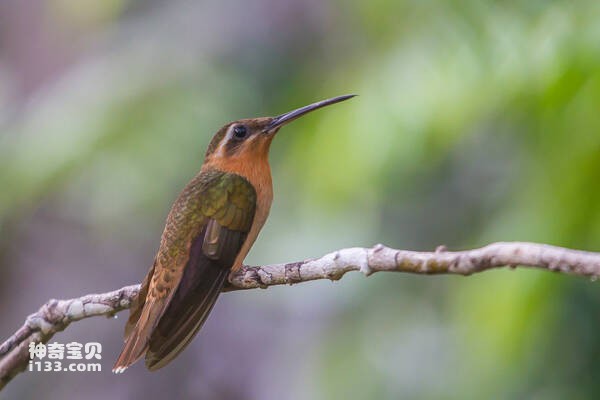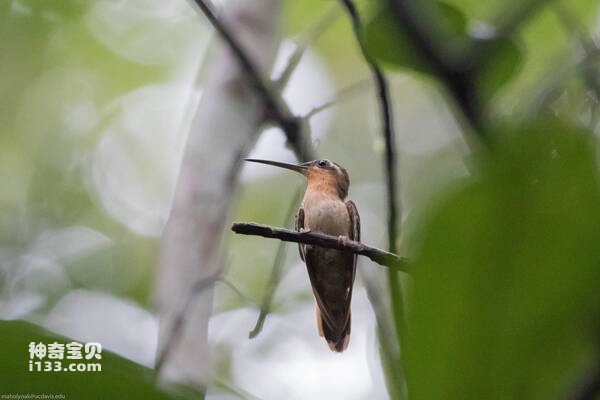Glaucis dohrnii
IUCN
LCBasic Information
Scientific classification
- name:Glaucis dohrnii
- Scientific Name:Glaucis dohrnii,Hook-billed Hermit
- Outline:Climbing birds
- Family:
Vital signs
- length:12-13.7 cm
- Weight:No textual research information is available
- lifetime:No textual research information is available
Feature
The body is generally dark, the upper body has a metallic sheen of copper-green feathers (including the head), the lower body is yellowish-brown
Distribution and Habitat
Native to Brazil, mainly distributed in eastern Brazil. It has been found sporadically in Bahia, Espirito Santo, and as far east as Minas Gerais.
It inhabits moist tropical lowland evergreen forests. Mainly distributed below 500 meters above sea level, along the river bed of the Hedya plants in full bloom in the brocade. The birds are often found deep in the forest, but they also visit ornamental flower areas in adjacent forests.
Appearance
The beak is slender, with a small hook at the end of the mouth, the upper mouth is black, the lower mouth is yellowish white. Legs yellow. The whole body is generally dark. The upper body has a metallic sheen of coppery green feathers (including the head), while the lower body is yellowish-brown.
The face is dark, with white stripes extending from the eyes and cheeks to the shoulders. The tail is coppery green, the base of the tail feathers is reddish-brown, with black stripes near the tail end. The adult body is 12~13.7 cm long. The female is slightly larger than the male, only the male's tail tip is white or off-white.
A similar species, the sawbill hummingbird (Ramphodon naevius), is larger and has thicker stripes on its underbody. The brown-breasted copper-colored hummingbird (Glaucis hirsutus) has a slightly downward curved bill, and the base of the four outer tail feathers is reddish-brown.
Details
Hook-billed copper hummingbird (Glaucis dohrnii) Hook-billed Hermit, no subspecies.

Hook-billed copper hummingbirds feed mainly on the nectar of a variety of bright, fragrant flowers from trees, herbs, shrubs and epiphytes. Prefers high-sugar nectar (usually from red tubular flowers). As a clip-feeding hummingbird, they travel across the land to feed on large areas of flowers (routes up to 1 km long), while most other hummingbirds are territorial foragers, where the males delimit the feeding area (picking out areas with high sugar content of flowers) and actively chase away intruders, other males and large insects (such as bumblebees, moths, etc.) that enter the territory. They protect their territory by flying and threatening.
They have long, retractable tongues shaped like straws that reach deep into flowers to feed on nectar, hovering with their tails up in the air and licking up to 13 times a second. Occasionally they hang from flowers during feeding. Many native and cultivated plants are heavily dependent on pollination by birds that feed on their flowers. For example, most plants with tubular flowers reject pollination by bees and butterflies, while hummingbirds do.
Hook-billed copper hummingbirds visit local hummingbird feeders that provide sugar water, hover or stand on the edge of a sink or sprinkler, and sip sugar water from it, drinking "standing" like other birds, but only for a short time. They also prey on small spiders and insects to ensure an adequate supply of protein, especially during brooding, to ensure the proper development of their young. It usually attacks insects in flight, but also those stuck in branches or spiderwebs. During the nesting period, females can catch up to 2,000 insects a day.

Based on a comprehensive assessment of known population records, abundance, and species-range distribution, the number of mature individuals is estimated at 250-999, which is consistent with population density estimates for similarly-sized hummingbirds of the same genus or related species. The total population of hook-billed copper hummingbirds ranges from 350 to 1,500 individuals. Based on the continuous destruction and fragmentation of habitat, the population is presumed to be declining at a moderate rate.
Listed in Appendix I, Appendix II and Appendix III of the Convention on International Trade in Endangered Species of Wild Fauna and Flora (CITES) 2019 edition.
Listed on the IUCN Red List of Threatened Species ver 3.1:2021 - Vulnerable (VU)
Protect wild animals and eliminate wild meat.
Maintaining ecological balance is everyone's responsibility!








